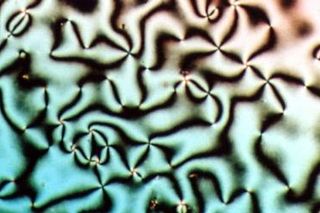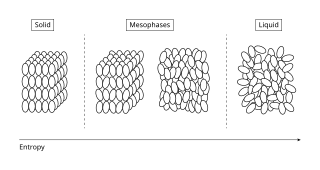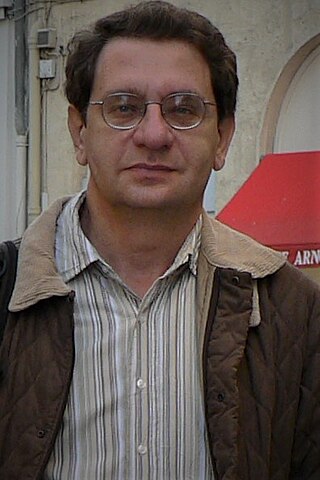
A liquid-crystal display (LCD) is a flat-panel display or other electronically modulated optical device that uses the light-modulating properties of liquid crystals combined with polarizers. Liquid crystals do not emit light directly but instead use a backlight or reflector to produce images in color or monochrome. LCDs are available to display arbitrary images or fixed images with low information content, which can be displayed or hidden: preset words, digits, and seven-segment displays are all examples of devices with these displays. They use the same basic technology, except that arbitrary images are made from a matrix of small pixels, while other displays have larger elements. LCDs can either be normally on (positive) or off (negative), depending on the polarizer arrangement. For example, a character positive LCD with a backlight will have black lettering on a background that is the color of the backlight, and a character negative LCD will have a black background with the letters being of the same color as the backlight. Optical filters are added to white on blue LCDs to give them their characteristic appearance.

Liquid crystal (LC) is a state of matter whose properties are between those of conventional liquids and those of solid crystals. For example, a liquid crystal may flow like a liquid, but its molecules may be oriented in a crystal-like way. There are many types of LC phases, which can be distinguished by their optical properties. The contrasting textures arise due to molecules within one area of material ("domain") being oriented in the same direction but different areas having different orientations. LC materials may not always be in an LC state of matter.
A thin-film transistor (TFT) is a special type of field-effect transistor (FET) where the transistor is made by thin film deposition. TFTs are grown on a supporting substrate. A common substrate is glass, because the traditional application of TFTs is in liquid-crystal displays (LCDs). This differs from the conventional bulk metal oxide field effect transistor (MOSFET), where the semiconductor material typically is the substrate, such as a silicon wafer.

A super-twisted nematic (STN) display is a type of monochrome passive-matrix liquid crystal display (LCD).

George William Gray was a Professor of Organic Chemistry at the University of Hull who was instrumental in developing the long-lasting materials which made liquid crystal displays possible. He created and systematically developed liquid crystal materials science, and established a method of practical molecular design. Gray was recipient of the 1995 Kyoto Prize in Advanced Technology.

Martin Schadt is a Swiss physicist and inventor.

George Harry Heilmeier was an American engineer, manager, and a pioneering contributor to liquid crystal displays (LCDs), for which he was inducted into the National Inventors Hall of Fame. Heilmeier's work is an IEEE Milestone.

In chemistry and chemical physics, a mesophase is a state of matter intermediate between solid and liquid. Gelatin is a common example of a partially ordered structure in a mesophase. Further, biological structures such as the lipid bilayers of cell membranes are examples of mesophases.
A blue phase mode LCD is a liquid crystal display (LCD) technology that uses highly twisted cholesteric phases in a blue phase. It was first proposed in 2007 to obtain a better display of moving images with, for example, frame rates of 100–120 Hz to improve the temporal response of LCDs. This operational mode for LCDs also does not require anisotropic alignment layers and thus theoretically simplifies the LCD manufacturing process.
There are various classifications of the electro-optical modes of liquid crystal displays (LCDs).
Ferroelectric Liquid Crystal Display (FLCD) is a display technology based on the ferroelectric properties of chiral smectic liquid crystals as proposed in 1980 by Clark and Lagerwall. Reportedly discovered in 1975, several companies pursued the development of FLCD technologies, notably Canon and Central Research Laboratories (CRL), along with others including Seiko, Sharp, Mitsubishi and GEC. Canon and CRL pursued different technological approaches with regard to the switching of display cells, these providing the individual pixels or subpixels, and the production of intermediate pixel intensities between full transparency and full opacity, these differing approaches being adopted by other companies seeking to develop FLCD products.

Sivaramakrishna Chandrasekhar FNA, FRS was an Indian physicist who won the Royal Medal in 1994. He was the founder-president of the International Liquid Crystal Society.

4-Cyano-4'-pentylbiphenyl is a commonly used nematic liquid crystal with the chemical formula C18H19N. It frequently goes by the common name 5CB. 5CB was first synthesized by George William Gray, Ken Harrison, and J.A. Nash at the University of Hull in 1972 and at the time it was the first member of the cyanobiphenyls. The liquid crystal was discovered after Gray's group received a grant from the UK Ministry of Defence to find a liquid crystal that had liquid crystal phases near room temperature with the specific intention of using them in liquid crystal displays. The molecule is about 20 Å long. The liquid crystal 5CB undergoes a phase transition from a crystalline state to a nematic state at 22.5 °C and it goes from a nematic to an isotropic state at 35.0 °C.
Electrically operated display devices have developed from electromechanical systems for display of text, up to all-electronic devices capable of full-motion 3D color graphic displays. Electromagnetic devices, using a solenoid coil to control a visible flag or flap, were the earliest type, and were used for text displays such as stock market prices and arrival/departure display times. The cathode ray tube was the workhorse of text and video display technology for several decades until being displaced by plasma, liquid crystal (LCD), and solid-state devices such as thin-film transistors (TFTs), LEDs and OLEDs. With the advent of metal–oxide–semiconductor field-effect transistors (MOSFETs), integrated circuit (IC) chips, microprocessors, and microelectronic devices, many more individual picture elements ("pixels") could be incorporated into one display device, allowing graphic displays and video.

In optics, a nematicon is a spatial soliton in nematic liquid crystals (NLC). The name was invented in 2003 by G. Assanto. and used thereafter Nematicons are generated by a special type of optical nonlinearity present in NLC: the light induced reorientation of the molecular director. This nonlinearity arises from the fact that the molecular director tends to align along the electric field of light. Nematicons are easy to generate because the NLC dielectric medium exhibits the following properties:
A liquid-crystal laser is a laser that uses a liquid crystal as the resonator cavity, allowing selection of emission wavelength and polarization from the active laser medium. The lasing medium is usually a dye doped into the liquid crystal. Liquid-crystal lasers are comparable in size to diode lasers, but provide the continuous wide spectrum tunability of dye lasers while maintaining a large coherence area. The tuning range is typically several tens of nanometers. Self-organization at micrometer scales reduces manufacturing complexity compared to using layered photonic metamaterials. Operation may be either in continuous wave mode or in pulsed mode.

Guest Host Displays, Dichroic Displays, Polymer Dispersed Displays

Nelamangala Vedavyasachar Madhusudana is an Indian physicist and an emeritus scientist at Raman Research Institute. Known for his research on liquid crystals, Madhusudhana is an elected fellow of Indian Academy of Sciences and Indian National Science Academy. The Council of Scientific and Industrial Research, the apex agency of the Government of India for scientific research, awarded him the Shanti Swarup Bhatnagar Prize for Science and Technology, one of the highest Indian science awards, for his contributions to physical sciences in 1989.
Noel Anthony Clark is an American physicist, university professor at the University of Colorado Boulder, and pioneer in the development of electro-optical applications of liquid crystals.

Yuriy Reznikov was a Ukrainian physicist, Head of the Department of Crystals at NASU Institute of Physics and a world-renown expert in the field of liquid crystals. He is known for his work on photoalignment, "giant" optical non-linearity of liquid crystals and nano-colloids.












